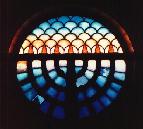| Orthodox Conversion to Judaism |
| The Jewish Calendar |
| The Jewish day runs from sundown to sundow, holidays start the evening of the secular day before secular c lendar date of the holiday The civil (or Julian) calendar is based on the cycle of the Earth around the sun. The length of this cycle, the solar year, is very close to 365 days. The Hebrew calendar is based on the cycle of the moon arround the Earth. The length of this cycle, the lunar month, is about 29 and a half days. Twelve lunar months make therefor about 354 days, which is 11 and a quarter days shorter then the solar year. In biblical times, the arrival of the new month was determined by watching the phase of the moon. However in modern times a fixed calendar is used in which the length of the months alternates between 29 and 30 days. |
| The months of the Hebrew calendar are: Tishrei - 30 days Cheshvan - 29/30 days Kislev - 29/30 days Tevet - 29 days Shvat - 30 days Adar - 29 days |
| The difference of the 11 and a quarter days between the 12 lunar months and one solar year accumulates in three years to more then a month. If no adjustments are made, a summer month like Av or Elul could shift to the winter. Because the Jewish holidays are closely related to the seasons (for example, the Torah commands to celebrate Pesach in the spring), an adjustment to the calendar must be made every few years. Every two or three years one extra month is added to a year. Such a year is called a leap year and it has two months of Adar. |
 |
| Nisan - 30 days Iyyar - 29 days Sivan - 30 days Tamuz - 29 days Av - 30 days Elul - 29 days |
| The months in a leap year are:: Tishrei - 30 days Cheshvan - 29/30 days Kislev - 29/30 days Tevet - 29 days Shvat - 30 days Adar 1 - 30 days Adar 2 - 29 days |
| Nisan - 30 days Iyyar - 29 days Sivan - 30 days Tamuz -29 days Av - 30 dys Elul - 29 days |
| Holidays that occur in the month of Adar (such as Purim) are celebrated in Adar 2 in a leap year. The same rule is applied to birthdays, anniversaries and other personal events. The following 19 year cycle determines when a year is a leap year. |
| 1. regular 2. regular 3. leap 4. regular 5. regular 6. leap |
| 7. regular 8. meap 9. regular 10. regular 11. leap 12. regular |
| 13. regular 14. leap 15. regular 16. regular 17. leap 18. regular 19. leap |
| In addition to the leap year cycle, he length of each year is slightly adjusted to meet a number of constraints called Dechiot. These small adjustments are made by selecting the length of the two months of Cheshvan and Kislev to be 29 or 30 days. The four constraints (Dechiot) can be pre-calculated and represented in tables of short cycles. Hebrew calendar software programs use relatively simple table lookup to determine the exact lenght of a given year and the date of Rosh HaShana. All the other dates and holidays are calculated by counthing up from Rosh HaShana. |
| Home - Library - Links - Email - Holidays - Laws of Yom Tov - Tu B'Shevat/Purim |